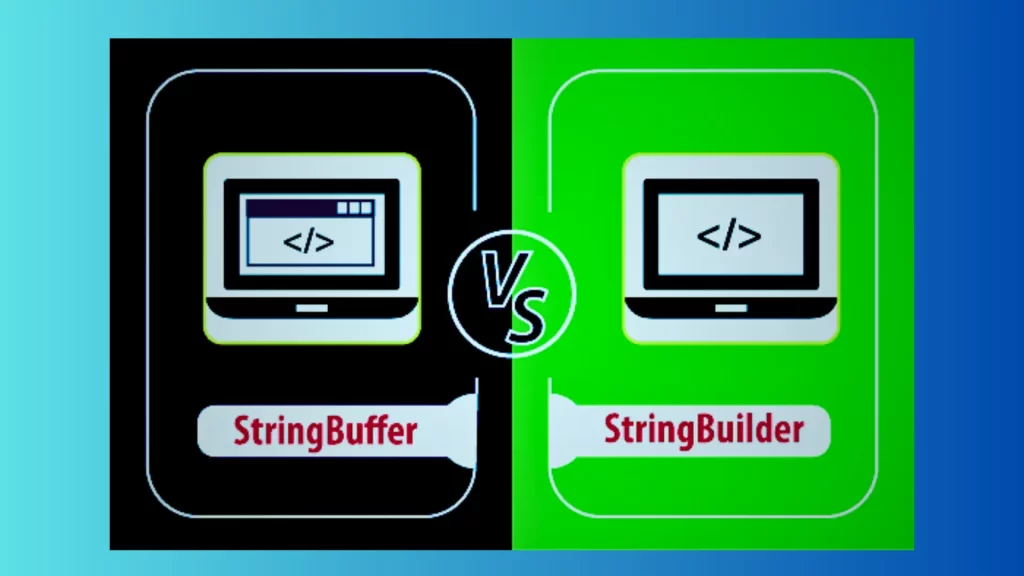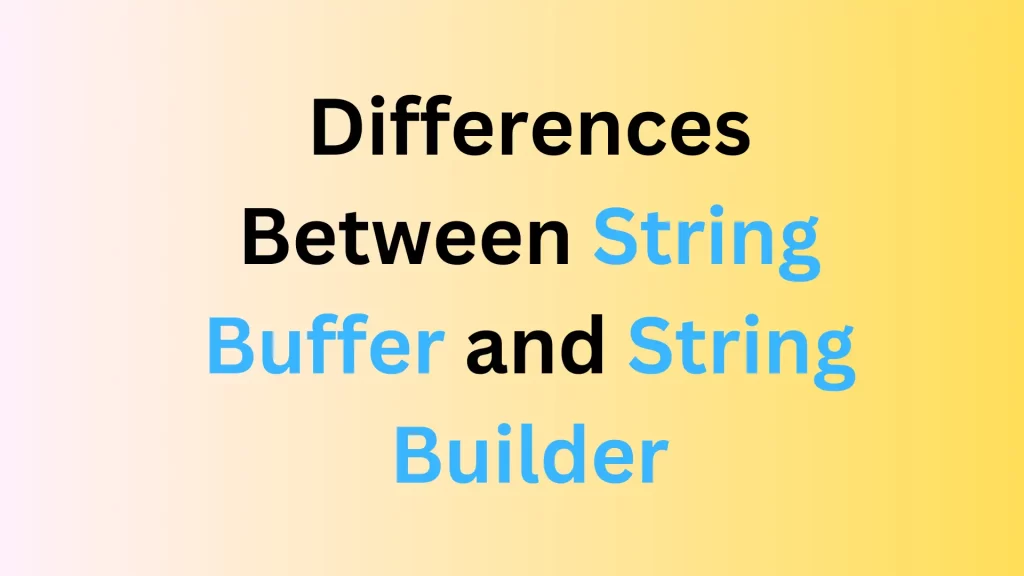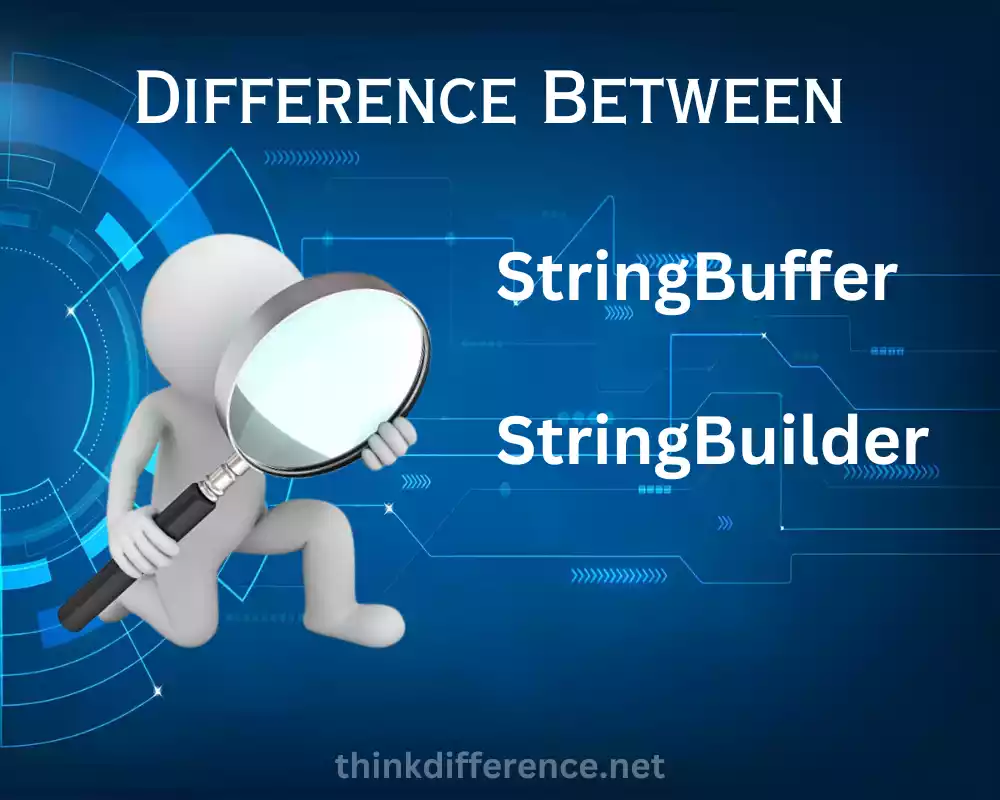Brief overview of String Buffer and String Builder
StringBuffer and StringBuilder classes in Java provide methods for manipulating strings. Their main purposes include appending new characters onto existing ones by appending or inserting characters at specific places within a string, adding or deleting characters as necessary, etc.

StringBuffer offers multithreaded programs thread safety while StringBuilder speeds things up faster but shouldn’t be used this way. Both classes are widely utilized across applications to optimize string manipulation operations efficiently.
What is a String Buffer?
StringBuffer can be changed, unlike its immutable String counterpart, providing dynamic character string changes via specific methods called by multiple threads at any one time. StringBuffer supports synchronization so only one thread at once may call its methods simultaneously. A thread-safe changeable character string. StringBuffer supports thread safety for changes while being thread-safe due to dynamic character string changes via special methods called by specific methods.
Dynamic character strings with variable capacity that supports dynamic thread usage can all use this particular class without compromising to security imposed upon using StringBuffer methods simultaneously across threads without compromise as only one thread may call its methods at any one time and dynamic character strings can change dynamically while string classes do not.
This example implements an asynchronous StringBuilder. Multiple threads may call its methods simultaneously.
String Buffer (new String Buffer) will serve as an identifier of its contents.
String Buffer Example
Public class “StringBuffer”, For Example public static void main (With String arguments).
System.out.println(“StringBuffer Example” +buffer); public class StringBufferExample; public static void main(String[] args]); StringBuffer buffer=new StringBuffer(“Hi”); buffer.append(“Java 8”).
What is a String Builder?
Java’s StringBuilder class represents an alterable sequence of characters. It replaces Java’s String Class by creating an adaptable series of characters rather than one static series which cannot be altered, thus permitting multiple threads to access StringBuilder functions simultaneously. Asynchronous string builders allow multiple users to access their features. StringBuilder is much quicker than StringBuffer because there is no initial check on multiple threads.

StringBuffer and StringBuilder classes serve similar functions; both serve as alternatives to the String class by creating variable sequences of characters. Their only difference lies in how their synchronization mechanisms operate.
StringBuilder is a Java class that represents an extensible string of characters that can be altered. StringBuilder is an alternative Java class designed to replace the String Class by providing an easily editable sequence of characters rather than its immutable characters sequences. String Builder stands apart from its String Buffer counterpart by guaranteeing synchronization of threaded processing.
This class was intended for use when StringBuffer instances have been shared across multiple threads – as is often the case. StringBuilders should always be preferred over StringBuffer as they tend to be faster. Instances should never be shared among multiple threads.
String Builder Example
- String Builder(): creates a string constructor with capacities beginning at 16 characters.
- String Builder(int capacity): Creates a string with capacity initialized by parameter capacity but without characters.
- Creates a string builder using characters similar to those provided in Char Sequence using String Builder(Char Sequence seq).
- String Builder (String str): Creates a builder which utilizes the specified text string as its initial value.
In this example, we’ll create two values – a Boolean with an initial value and an empty StringBuilder as its starting point – then call Append() on them both to append them together.
System. out.println(“String Builder Example”, builder); This example class String Builder Example provides public static void main(String[] args) String Builders which use new String Builder(“Hi”); builder.append(“Java 8”).
Differences Between String Buffer and String Builder

- Performance: StringBuilder outperforms StringBuffer due to not relying on synchronization for performance reasons, although both may be suitable in multithreaded apps; though StringBuffer might perform slower due to this requirement. StringBuilder should be chosen when thread safety does not need to be assured; so consider it when possible!
- Thread-Safety: The StringBuffer class supports multithreaded environments without inconsistency of data being created or any other issues arising; unlike StringBuilder which does not. Therefore it may cause issues when used within such environments.
- Synchronization: StringBuffer uses locks to ensure only one thread at any given time can access its data, while StringBuilder does not synchronize, meaning multiple threads may access its content simultaneously.
- Memory Allocation: StringBuffer uses slightly more memory due to synchronization; in comparison, StringBuilder offers greater efficiency as it doesn’t need any memory for locks or buffering purposes.
- Usability: StringBuffer should only be used in multithreaded applications that demand thread safety; StringBuilder, on the other hand, should only be employed when thread safety may not be needed – such as single-threaded apps and when dealing with short or small strings.
- Comparison of methods: Methods are similar for both StringBuffer (for appending characters) and StringBuilder (for inserting and deleting them). StringBuffer offers some unique methods not seen elsewhere – ensure Capacity() for allocating memory for their StringBuffer is one such example.
Performance Test of String Buffer and String Builder
Java’s documentation suggests using StringBuilder instead of StringBuffer due to the former being faster due to not requiring synchronization. Below you’ll find performance benchmark tests that measure how quickly StringBuffer or StringBuilder objects respond when repeatedly calling their append() methods.
This app illustrates the advantage of employing the StringBuilder Class over the StringBuffer Class when used on objects containing “Scaler.” After continuously adding random strings, we measured how quickly each one completed an identical task.
StringBuffer methods synchronize, while StringBuilder does not, which results in differences in speed between them. StringBuffer has more security but may take longer due to synchronization mechanisms.
Conversion From String Buffer to String Builder
StringBuffers cannot be directly converted to StringBuilders; we first must convert our StringBuffer to an actual String object using the native code function ‘to String(). After creating our first object of type ‘String, we can then convert that String object using its class Object() function [native code].
Benchmark tests demonstrate that StringBuilder consumes twice as much time compared to StringBuffer; its thread safety comes at the cost of performance; in general, StringBuilder should be chosen over String Buffer when thread safety does not matter and vice versa; StringBuffer should only be employed if thread safety is required.
StringBuffer cannot be directly converted to StringBuilder as described previously, so to start this conversion we need to call on the native code function String() as our starting point.
Convert a StringBuilder into a String object using native code function Object() and we’re now able to use StringBuilder Storage Frame as our construction source.
When to Use StringBuffer and StringBuilder
Your decision of StringBuffer or StringBuilder depends upon your application needs. Consider these aspects when making this choice:
There was much merriment around when they found out their uncle had left for Australia to become their new neighbors in Canberra! Now a week on from then though they find out he’s gone they start making changes which hopefully won’t take too much getting used to, or just keep getting worse – something which I know all too well after 25 years with my beloved nan and uncle Paul (you’ve probably met both on many an outing).
So they go in search of happiness elsewhere… and don’t stop until they reach where ever you might find one is; somewhere between then and there being two extremes when trying out something of greatness or else will occur…!? They’ll discover it sooner, too… then.
- Thread-safety: When your application requires multiple threads accessing and manipulating a string object simultaneously, StringBuffer should be chosen because it provides thread safety. On the other hand, StringBuilder would work well if your app will only involve single-threading; only one thread needs accessing or manipulating its object at any given time.
- Performance: For high-performance string manipulation with thread safety, not an issue, StringBuilder offers faster performance due to not needing to deal with synchronization overhead.
- Memory Usage: StringBuffer can be an ideal option if memory usage is an issue and performance is of secondary concern to an application. Stringbuffer consumes more memory due to synchronization overhead; It still serves its purpose when an app needs a large allocation for string manipulation purposes.
- String Length: String Builder and StringBuffer should both work effectively if the string being altered has a relatively short length; otherwise they should both provide similar performance but it depends on whether your string requires manipulation that spans multiple characters (tens or thousands). String Builder may be faster while using less memory resources.
StringBuffer should be utilized when thread safety is required; while StringBuilder provides high-performance string manipulation without thread safety concerns.
Conclusion
This article should have provided clarity between StringBuffer and StringBuilder, and Simplilearn’s Full Stack Web Developer course is the ideal way for software developers to expand their software development skills quickly. Developed in cooperation with Caltech CTME, this course equips learners with all of the skills required for professional success – quickly positioning themselves for employment after graduation!
Please post any inquiries in the comment section. Our team will get back to you as quickly as possible!



